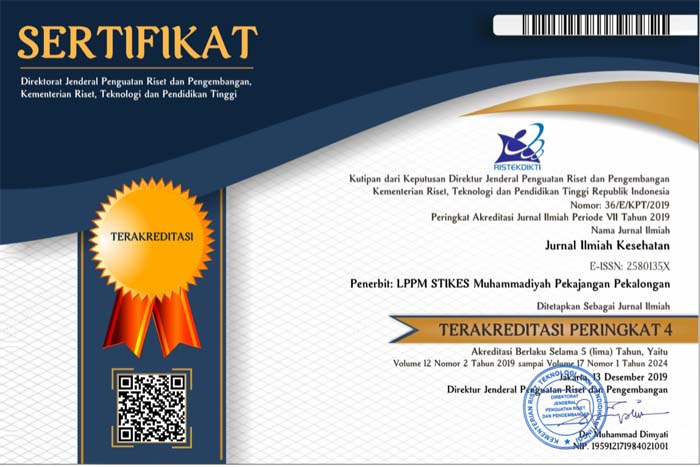Gambaran Diagnosis Keperawatan Di IGD RSJ Grhasia Yogyakarta
DOI:
https://doi.org/10.48144/jiks.v14i2.580Abstract
Diagnosis keperawatan menyediakan dasar untuk pemilihan intervensi keperawatan bagi perawat dengan hasil yang bisa dipertangungjawabkan. Tujuan penelitian ini adalah untuk mengetahui gambaran diagnosis keperawatan di Instalasi Gawat Darurat Rumah Sakit Jiwa Grhasia Yogyakarta.Penelitian ini merupakan penelitian kuantitatif dengan metode analitik deskriptif. Populasi dalam penelitian ini adalah pasien IGD RSJ Grhasia Yogyakarta pada tahun 2019 yang berjumlah 2.200. Teknik sampling menggunakan total sampling, artinya semua populasi dijadikan sampel dalam penelitian sehingga jumlah sampel adalah 2.200 orang. Data diagnosis keperawatan diperoleh secara sekunder dari sistem informasi asuhan keperawatan RSJ Grhasia Yogyakarta. Analisa data dilakukan secara univariat yang menghasilkan distribusi frekuensi dan presentase setiap diagnosis keperawatan. Hasil Penelitian menunjukkan diagnosis keperawatan yang paling banyak terjadi adalah adalah perilaku kekerasan (41,50%), pada urutan kedua dan seterusnya adalah halusinasi (38,64%), defisit perawatan diri (29,82%), dan waham (11,73%). Peneliti menganggap perlu dilakukan penelitian lain yang lebih detail tentang diagnosa keperawatan di IGD RSJ grhasia seperti hasil pemeriksaan status mental ataupun tanda gejala yang dialami pasien yang digambarkan berdasarkan diagnosa keperawatan.
Kata kunci: Diagnosis keperawatan; kegawatdaruratan psikiatri
References
“Undang-Undang Republik Indonesia Nomor 18 Tahun 2014 Tentang Kesehatan Jiwa.”
WHO, “Schizophrenia and public health,” Geneva, 2016.
Kemenkes RI, “Hasil Utama Riskesdas 2018,” Jakarta, 2018.
RSJ Grhasia, “Sistem Informasi dan Manajemen Keperawatan,” 2020.
L. J. Capernito, Diagnosa Keperawatan : Aplikasi pada Praktek Klinik. Jakarta: EGC, 2013.
American Nurses Association, “The Nursing Process,” 2016. [Online]. Available: https://www.nursingworld.org/practice-policy/workforce/what-is-nursing/the-nursing-process/. [Accessed: 13-Sep-2020].
T. H. Herdman and S. Komitsuru, NANDA International Nursing Diagnoses: Definitions & Classification. Jakarta: EGC, 2018.
RSJ Grhasia, Panduan Asuhan Keperawatan (PAK) RSJ Grhasia. 2019.
PPNI, Standar Diagnosis Keperawatan Indonesia, 1st ed. Jakarta: DPP PPNI, 2016.
WHO, “Definition and typology of violence.” [Online]. Available: https://www.who.int/violenceprevention/approach/definition/en/. [Accessed: 10-Sep-2020].
R. Van Dorn, J. Volavka, and N. Johnson, “Mental disorder and violence: Is there a relationship beyond substance use?,” Soc. Psychiatry Psychiatr. Epidemiol., vol. 47, no. 3, pp. 487–503, 2012, doi: 10.1007/s00127-011-0356-x.
K. Kandar and D. I. Iswanti, “Faktor Predisposisi dan Prestipitasi Pasien Resiko Perilaku Kekerasan,” J. Ilmu Keperawatan Jiwa, vol. 2, no. 3, p. 149, 2019, doi: 10.32584/jikj.v2i3.226.
F. Frauenfelder, T. van Achterberg, and M. Müller Staub, “Nursing Diagnoses Related to Psychiatric Adult Inpatient Care,” J. Clin. Nurs., vol. 27, no. 3–4, pp. e463–e475, 2018, doi: 10.1111/jocn.13959.
V. Negatsch, A. Voulgaris, P. Seidel, R. Roehle, and A. Opitz-Welke, “Identifying violent behavior using the Oxford mental illness and violence tool in a psychiatric ward of a German prison hospital,” Front. Psychiatry, vol. 10, no. APR, pp. 1–10, 2019, doi: 10.3389/fpsyt.2019.00264.
L. Iozzino, C. Ferrari, M. Large, O. Nielssen, and G. De Girolamo, “Prevalence and risk factors of violence by psychiatric acute inpatients: A systematic review and meta-analysis,” PLoS One, vol. 10, no. 6, 2015, doi: 10.1371/journal.pone.0128536.
M. C. Townsend, Psychiatric Mental Health Nursing: Concepts of Care in Evidence-Based Practice, 8th ed. Philadelphia: F. A. Davis Company, 2015.
D. Wahyuningsih, B. Keliat, and S. . Hastono, “Penurunan Perilaku Kekerasan pada Klien Skizofrenia dengan Assertiveness Training,” J. Keperawatan Indones., vol. 14, no. 1, pp. 51–56, 2011.
G. W. Stuart, Prinsip dan Praktik Keperawatan Kesehatan Jiwa Stuart, 1st Indone. Singapore: Elsevier, 2016.
A. Lim et al., “Prevalence and classification of hallucinations in multiple sensory modalities in schizophrenia spectrum disorders,” Schizophr. Res., vol. 176, no. 2–3, pp. 493–499, 2016, doi: 10.1016/j.schres.2016.06.010.
F. Waters and C. Fernyhough, “Hallucinations: A systematic review of points of similarity and difference across diagnostic classes,” Schizophr. Bull., vol. 43, no. 1, pp. 32–43, 2017, doi: 10.1093/schbul/sbw132.
J. Laloyaux et al., “Multimodal hallucinations are associated with poor mental health and negatively impact auditory hallucinations in the general population: Results from an epidemiological study,” Schizophr. Res., vol. 210, pp. 319–322, 2019, doi: 10.1016/j.schres.2019.06.005.
P. H. Livana and T. Suerni, “Overview of the Role of Nurses in the Implementation of Education in Patients Hallucinations,” Eur. J. Biophys., vol. 7, no. 2, p. 43, 2019, doi: 10.11648/j.ejb.20190702.12.












